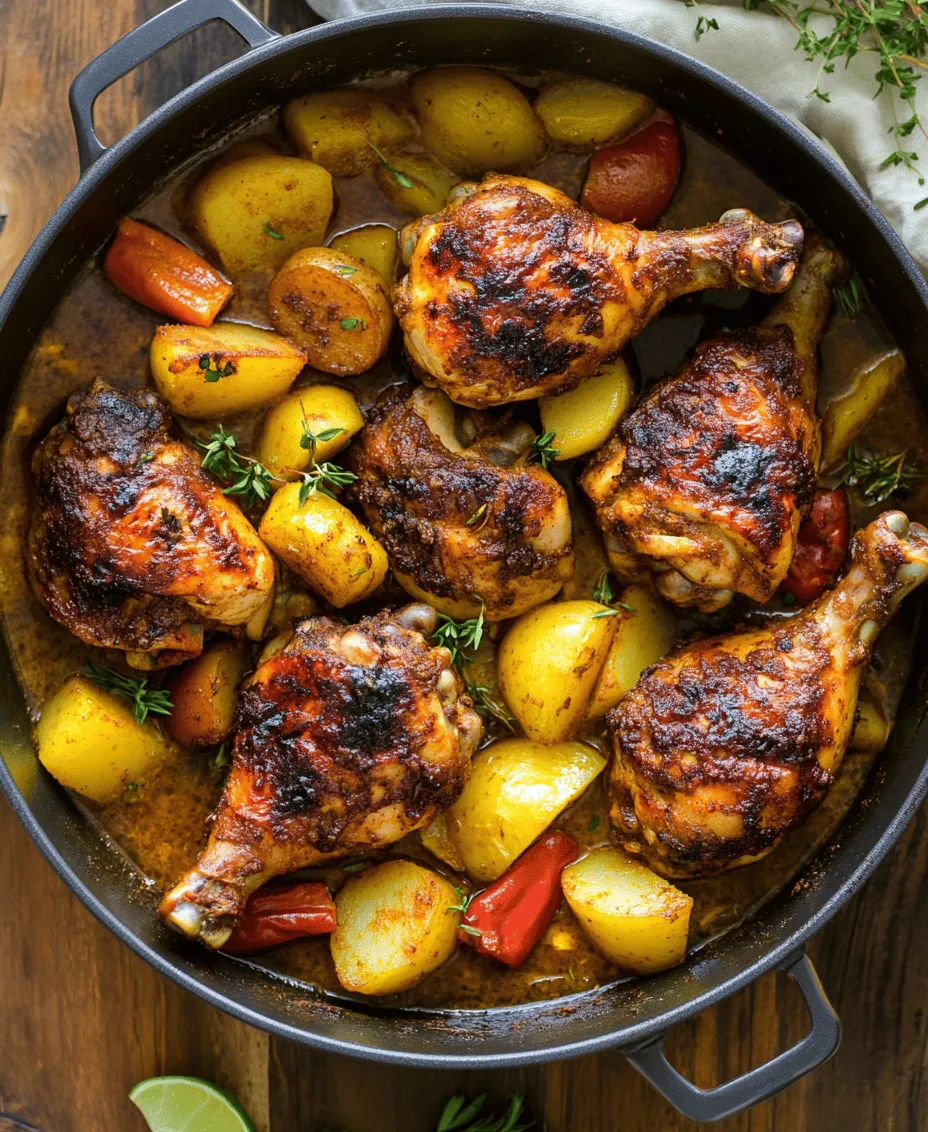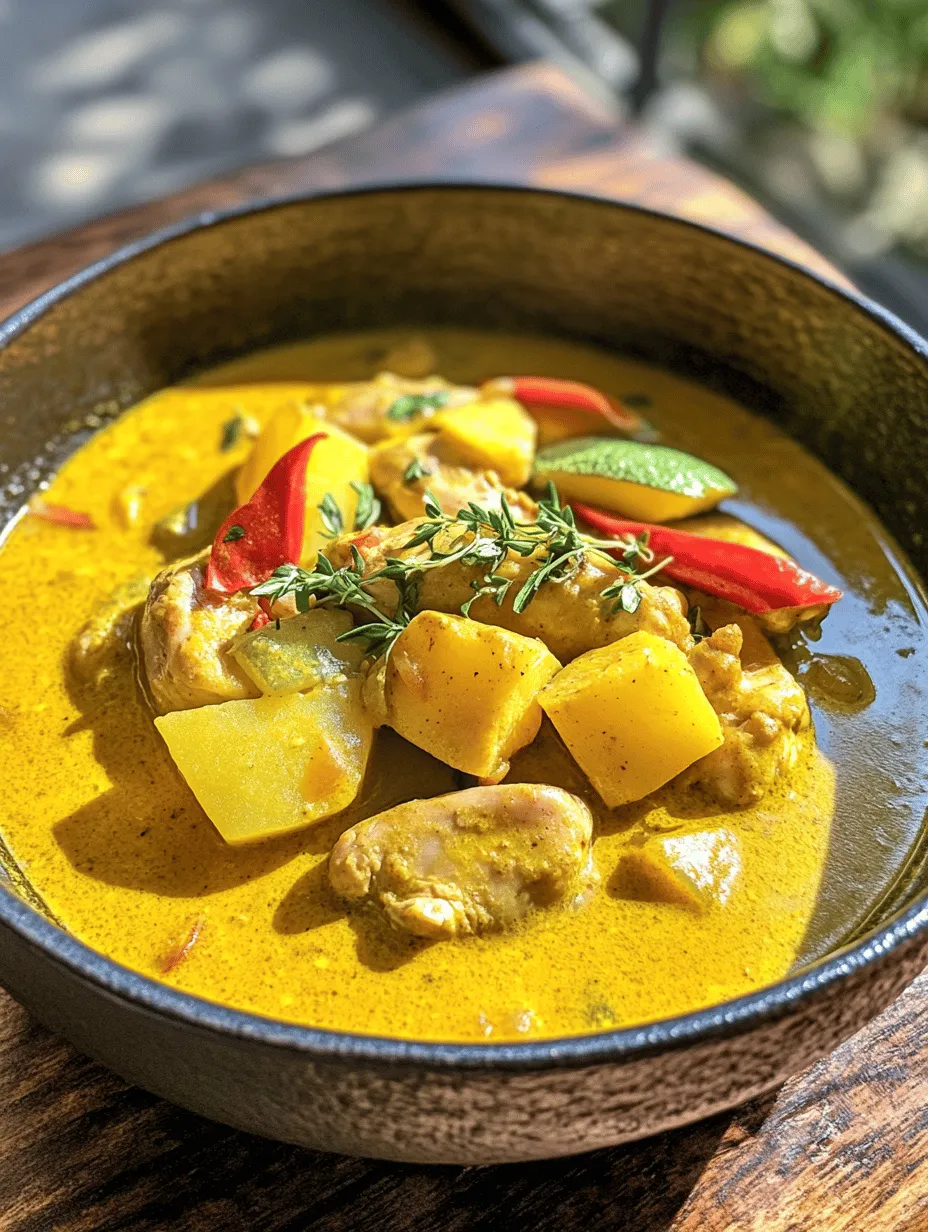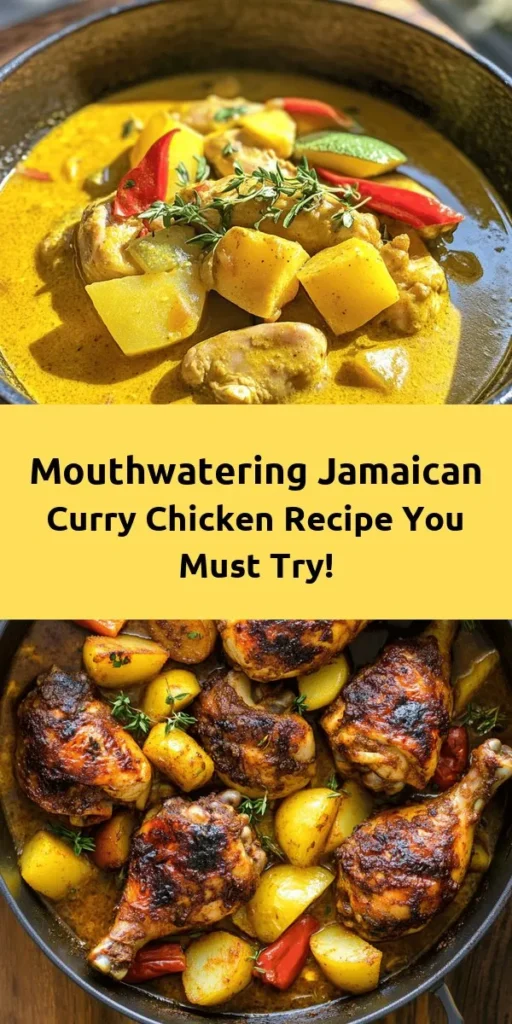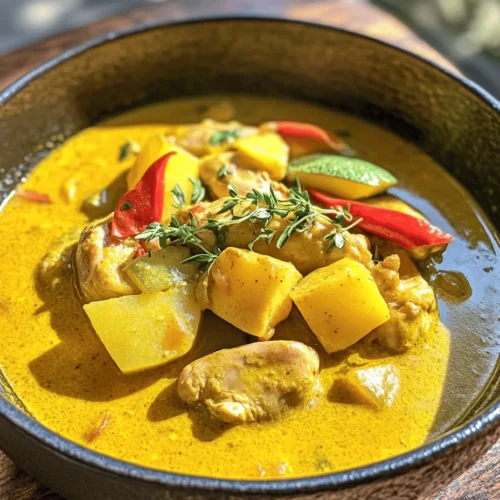Introduction
Jamaican cuisine is a vibrant tapestry woven from the diverse threads of its rich cultural history. This island’s culinary landscape is shaped by the influences of its indigenous Taino people, African heritage brought by enslaved individuals, and later, the culinary practices introduced by Indian and Chinese immigrants. Each of these cultures has left an indelible mark on Jamaican food, creating a unique and exciting fusion that tantalizes the taste buds. Among the many delicious dishes that grace Jamaican tables, curry chicken stands out as a beloved staple, cherished in households across the island.
Curry chicken is not merely a meal; it is a celebration of flavors, colors, and aromas that reflects the warmth and hospitality of Jamaican culture. This dish is often a centerpiece at family gatherings, Sunday dinners, and special occasions, showcasing the island’s fondness for communal dining and shared experiences. The combination of tender chicken simmered in a fragrant sauce rich with spices and herbs makes it a comfort food that resonates with many.
What sets Jamaican curry chicken apart from its counterparts in other cultures is its distinctive flavor profile. The authentic taste arises from a careful balance of spices, fresh ingredients, and cooking techniques rooted in Jamaican tradition. The use of Jamaican curry powder, which differs from typical curry powders found elsewhere, incorporates a unique blend of spices that gives the dish its characteristic warmth and depth. Coupled with the fiery heat of Scotch bonnet peppers and the aromatic essence of fresh thyme, this dish embodies the spirit of Jamaica in every bite.
In this article, we will explore the essence of Jamaican curry chicken, delve into its historical background, and take a closer look at the ingredients that make it truly authentic. Additionally, we will guide you through the preparation steps necessary to create this mouthwatering dish in your own kitchen.
The Essence of Jamaican Curry Chicken
The history of curry in Jamaica is a fascinating tale that reflects the island’s multicultural influences. Although curry is often associated with Indian cuisine, its journey to Jamaica began during the 19th century when Indian indentured laborers arrived to work on sugar plantations after the abolition of slavery. They brought with them their culinary traditions, including their use of spices, which melded with local ingredients and cooking practices to birth a unique Jamaican interpretation of curry.
As the Indian community settled in Jamaica, they adapted their recipes to incorporate local produce and flavors, giving rise to a distinctive style of cooking that is both spicy and aromatic. The fusion of Indian spices with African and Caribbean ingredients created a flavor profile that is rich, complex, and utterly delicious.
In Jamaican cooking, spices are not just seasonings; they are the essence of the dish. The use of fresh, high-quality ingredients is paramount, as they serve to enhance the overall flavor and aroma of the curry. Jamaican curry chicken exemplifies this philosophy, with its rich blend of spices and fresh herbs working harmoniously to create a memorable culinary experience.
Historical Background of Curry in Jamaica
Curry’s introduction to Jamaica is a testament to the island’s history of migration and cultural exchange. The Indian laborers who brought curry to the island were not just introducing a new dish; they were sharing a culinary heritage that would be embraced and adapted by the local population. Over time, Jamaican curry has evolved into a dish that is distinctly Jamaican, reflecting the island’s identity and the diverse influences that have shaped its cuisine.
In Jamaican households, curry chicken is often cooked as a comforting meal, typically served with rice and peas or roti. The dish has become a symbol of Jamaican hospitality, with families often gathering around the table to enjoy a steaming pot of curry chicken, filled with the warmth and flavors of home.
Importance of Spices and Fresh Ingredients in Jamaican Cooking
At the heart of Jamaican curry chicken lies the importance of spices and fresh ingredients. The use of spices is integral to Jamaican cooking, with each ingredient playing a vital role in building flavor. The boldness of Jamaican curry powder, for instance, is complemented by the warmth of allspice, which adds a distinctive sweetness and depth to the dish.
Additionally, the incorporation of fresh herbs, such as thyme, is essential in Jamaican cuisine. Fresh thyme not only enhances the flavor of the curry but also contributes a fragrant aroma that elevates the dish. The balance of heat from Scotch bonnet peppers and the richness of coconut milk further rounds out the flavor profile, making Jamaican curry chicken a true culinary masterpiece.
Ingredients Breakdown
To create authentic Jamaican curry chicken, it is crucial to understand the role of each ingredient in the dish. Below, we will provide a detailed description of the key components that contribute to the rich flavors and textures of this beloved meal.
Chicken: Types and Cuts for Optimal Flavor and Texture
When it comes to chicken for curry, the best choices are typically bone-in pieces, such as thighs or drumsticks. These cuts contain more fat than chicken breasts, which helps to keep the meat tender and juicy during cooking. Bone-in chicken also adds depth of flavor to the curry, as the bones infuse the sauce with richness as they simmer.
For those who prefer a lighter option, skinless chicken breasts can be used, but they tend to dry out more quickly, so careful attention is needed during cooking. Regardless of your choice, ensure that the chicken is fresh and of high quality, as it will serve as the canvas for the dish’s vibrant flavors.
Jamaican Curry Powder: What Makes It Unique and How to Choose the Right Blend
The most defining ingredient in Jamaican curry chicken is undoubtedly the Jamaican curry powder. Unlike the generic curry powders found in many grocery stores, Jamaican curry powder is characterized by its distinct blend of spices, which typically includes turmeric, coriander, cumin, and fenugreek, among others.
The unique aspect of Jamaican curry powder lies in its formulation, which often features a higher ratio of turmeric, giving it a vibrant yellow color and a warm, earthy flavor. When selecting a curry powder, look for blends that are labeled as “Jamaican” to ensure you are getting the authentic flavor profile. Some local brands may even include additional spices, such as allspice, which further enhances the complexity of the curry.
Allspice: Flavor Profile and Significance in Caribbean Cooking
Allspice, often referred to as pimento in Jamaica, is another essential ingredient in this dish, adding a warm, aromatic flavor that is reminiscent of cloves, cinnamon, and nutmeg. This unique spice is native to the Caribbean and is widely used in Jamaican cuisine, making it a staple in many traditional dishes beyond curry chicken.
Allspice contributes a depth of flavor that complements the other spices in the curry, creating a harmonious blend that is both fragrant and delicious. When using allspice in your curry chicken, opt for whole berries or freshly ground allspice to maximize the flavor.
Aromatics: The Role of Onion, Garlic, and Ginger in Building Flavor
The foundation of any good curry lies in its aromatics. In Jamaican curry chicken, onions, garlic, and ginger work together to build a rich base of flavor.
– Onions: Sautéing onions until they are soft and translucent releases their natural sweetness, which balances the heat of the spices. They add depth and complexity to the sauce, making them an essential component of the dish.
– Garlic: Fresh garlic brings a pungent and aromatic quality that enhances the overall flavor profile. It should be minced or finely chopped to ensure that its flavor permeates the dish during cooking.
– Ginger: Fresh ginger adds a spicy warmth that brightens the curry and complements the other ingredients. Its zesty notes provide an additional layer of flavor that is characteristic of Jamaican cooking.
Scotch Bonnet Peppers: Understanding Heat Levels and Flavor Nuances
No discussion of Jamaican curry chicken would be complete without mentioning Scotch bonnet peppers. Known for their fiery heat, these peppers are a staple in Jamaican cuisine and are often used to add both spice and flavor to dishes.
When using Scotch bonnet peppers, it is essential to consider the heat level, as they can vary significantly. For those who prefer a milder curry, it is advisable to remove the seeds and membranes before adding them to the dish, as these parts contain the highest concentration of heat. Alternatively, you can adjust the amount used according to your personal preference, ensuring that the final dish balances heat with flavor.
Fresh Thyme: Its Importance in Traditional Jamaican Dishes
Fresh thyme is a quintessential herb in Jamaican cooking, known for its aromatic profile and ability to enhance the flavor of various dishes. In curry chicken, thyme adds a refreshing note that contrasts beautifully with the robust spices, creating a well-rounded flavor experience.
When using thyme, opt for fresh sprigs over dried thyme to capture the herb’s vibrant flavor. Simply add it to the curry during cooking, allowing its essence to infuse the sauce.
Coconut Milk: How It Enriches the Curry and Balances Spices
Coconut milk is often used in Jamaican curry chicken to add richness and creaminess to the sauce. It serves to balance the heat of the spices and the savory elements of the dish, creating a harmonious flavor profile that is both comforting and satisfying.
When selecting coconut milk, look for high-quality, full-fat options to achieve the best results. The creaminess of the coconut milk not only enhances the texture of the curry but also adds a subtle sweetness that complements the spices beautifully.
Potatoes: Adding Heartiness and Texture to the Dish
Potatoes are a common addition to Jamaican curry chicken, providing heartiness and texture to the dish. They absorb the flavors of the curry, becoming flavorful and tender as they cook.
When using potatoes, it is best to choose waxy varieties, such as red or new potatoes, which hold their shape well during cooking. Cut them into uniform pieces to ensure even cooking and to allow them to soak up the delicious curry sauce.
Lime Juice: The Role of Acidity in Flavor Enhancement
Finally, a splash of fresh lime juice brightens the dish and adds a tangy acidity that enhances the overall flavor. The acidity helps to balance the richness of the coconut milk and the heat of the spices, providing a refreshing contrast that elevates the dish.
When preparing your Jamaican curry chicken, be sure to add lime juice at the end of cooking to preserve its bright flavor and zing.
Preparation Steps Explained
Now that we have explored the rich history and essential ingredients of Jamaican curry chicken, it’s time to delve into the preparation steps that will bring this dish to life in your kitchen.
Comprehensive Guide on Marinating Chicken
Marinating is a crucial step in achieving the best flavor and tenderness in your curry chicken. The marinade serves to infuse the chicken with spices and aromatics, enhancing its overall taste.
To prepare the marinade, combine Jamaican curry powder, minced garlic, grated ginger, chopped onions, and a splash of lime juice in a bowl. You can also add a touch of salt and pepper to taste. Mix the ingredients thoroughly to create a paste-like consistency.
Next, coat the chicken pieces in the marinade, ensuring that each piece is well-covered. For optimal flavor infusion, allow the chicken to marinate for at least 1-2 hours, but if time permits, marinating overnight in the refrigerator will yield even better results. This extended marination allows the spices to penetrate the meat, resulting in a more flavorful curry.
Importance of Marination for Flavor Infusion
The marination process is vital for developing the dish’s signature flavor profile. It not only enhances the taste of the chicken but also helps to tenderize the meat, ensuring that it remains juicy and succulent during cooking.
As the chicken marinates, the flavors meld together, creating a harmonious blend that will shine through in the final dish. This step is essential for achieving the authentic taste of Jamaican curry chicken, so do not skip it!
Tips for Achieving the Best Results
1. Use Fresh Ingredients: Whenever possible, opt for fresh herbs, spices, and produce to maximize flavor. Fresh ingredients will significantly enhance the overall taste of your curry chicken.
2. Adjust Spice Levels: If you are sensitive to heat, start with fewer Scotch bonnet peppers and gradually increase the amount to suit your taste. Remember, you can always add more heat, but it’s challenging to reduce it once it’s in the dish.
3. Cook Low and Slow: For the best flavor, allow the curry to simmer gently on low heat. This slow cooking process allows the spices to meld and develop their full flavors.
4. Taste and Adjust: Throughout the cooking process, taste the curry and adjust the seasoning as necessary. This is your opportunity to personalize the dish to your liking.
By following these preparation steps and tips, you will be well on your way to creating an authentic Jamaican curry chicken that captures the essence of Jamaican cuisine, delighting the palates of family and friends alike. Stay tuned for the next part of this article, where we will delve deeper into the cooking process, ensuring that you achieve a perfect, aromatic curry chicken every time.




